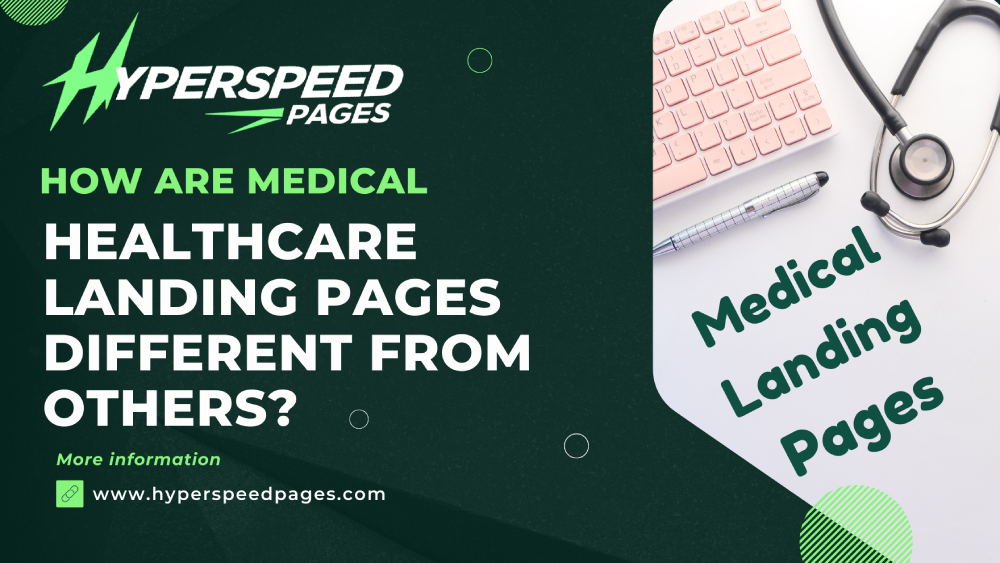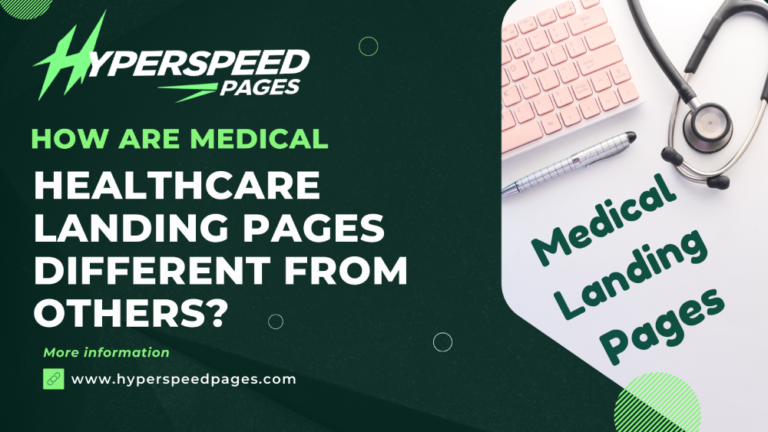
The design and functionality of a landing page vary significantly across different industries. When it comes to the medical and healthcare sectors, the differences are even more pronounced. This is primarily because these industries operate under stricter regulations, deal with sensitive information, and cater to an audience that prioritizes trust and credibility.
While the fundamental goal of a landing page remains consistent—to convert visitors into leads or customers—the nuances in achieving this objective vary drastically between sectors. Let’s look into the specific characteristics of medical landing pages, highlighting their distinct differences from other industries and the technical intricacies involved.
Unique Challenges of Healthcare
The healthcare industry is characterized by a complex interplay of factors that significantly influence web landing page design and strategy:
- High Stakes: Decisions made on healthcare landing pages often have direct implications on people’s health. This necessitates a heightened focus on trust, credibility, and transparency.
- Regulatory Compliance: The healthcare industry is subject to stringent regulations (e.g., HIPAA, FDA) that impose specific requirements on content, data handling, and privacy.
- Complex Decision-Making: Healthcare consumers often grapple with complex medical conditions and treatment options, demanding clear, informative, and empathetic communication.
- Trust and Credibility: Building trust is paramount in healthcare. Patients and providers need to be assured of the website’s authenticity and the competence of the organization.
Key Differentiators of Medical/Healthcare Landing Pages
1. Regulatory Compliance and Data Security
One of the most significant differences between healthcare landing pages and those in other industries is the need for regulatory compliance. In the healthcare sector, landing pages must adhere to strict regulations such as the Health Insurance Portability and Accountability Act (HIPAA) in the United States, the General Data Protection Regulation (GDPR) in Europe, and various other local laws worldwide.
a) HIPAA Compliance
Healthcare landing pages must ensure that any patient information collected is protected in compliance with HIPAA regulations. This means that all forms, chatbots, or any other methods of data collection must use secure methods of transmission and storage. Encryption, secure sockets layer (SSL) certificates, and secure hosting environments are critical to protecting patient data.
b) GDPR Compliance
For landing pages targeting European audiences, GDPR compliance is essential. This involves obtaining explicit consent from users before collecting their data, providing clear information on how their data will be used, and ensuring users have the right to access, correct, or delete their data.
c) Transparency and Trust
Healthcare landing pages must establish a high level of trust with visitors. This is often achieved through clear privacy policies, trust badges, and certifications that demonstrate the organization’s commitment to protecting patient data.
2. User Experience (UX) and Accessibility
The user experience on a healthcare landing page needs to be designed with the patient in mind, which differs significantly from other industries. Visitors to a healthcare site are often seeking information about serious and sometimes urgent issues, which means the UX design must be intuitive, supportive, and focused on clarity.
a) Clarity and Simplicity
Healthcare landing pages should prioritize simplicity in design. The information provided should be easy to understand, avoiding technical jargon or complex language that could confuse or overwhelm users. This is particularly important for patients who may be in distress or are not familiar with medical terminology.
b) Accessibility Standards
Healthcare landing pages must comply with accessibility standards, such as the Web Content Accessibility Guidelines (WCAG). This ensures that all users, including those with disabilities, can access and navigate the site. Features like screen reader compatibility, keyboard navigation, and text alternatives for images are not just optional but necessary for healthcare landing pages.
c) Mobile Optimization
Given the growing number of users accessing websites via mobile devices, it’s crucial that healthcare landing pages are fully optimized for mobile. A responsive design that adjusts to different screen sizes and maintains functionality across devices is essential to cater to all users.
3. Content Strategy and Tone
The content on a healthcare landing page must be handled with care, considering the sensitive nature of the subject matter. Unlike other industries where marketing messages might focus on persuasion and sales, healthcare content must be informative, empathetic, and authoritative.
a) Authoritativeness and Accuracy
Content must be written or reviewed by professionals with medical expertise. This not only ensures that the information is correct but also builds credibility with the audience. Citations from reputable medical journals, professional associations, and government health sites can further enhance the content’s authority.
b) Empathy and Reassurance
Healthcare content must also strike a balance between professionalism and empathy. The tone should be reassuring, focusing on the well-being of the patient rather than just promoting a product or service. This involves using language that is compassionate and supportive, addressing the patient’s concerns directly.
c) Educational Focus
Many healthcare landing pages serve an educational purpose, helping patients understand their condition, treatment options, or the services offered by a healthcare provider. This educational content should be presented in a way that is easily digestible, using bullet points, headings, and visual aids to break down complex information.
4. Call to Action (CTA) Design
While the primary goal of a landing page in most industries is to convert visitors into leads or customers, the approach in the healthcare sector is more nuanced.
a) Soft CTAs
Instead of aggressive sales tactics, healthcare landing pages often use soft CTAs, such as inviting users to learn more about a condition, download a free guide, or schedule a consultation. The emphasis is on providing value and support rather than making a quick sale.
b) Appointment Scheduling
One of the most common CTAs on a healthcare landing page is the option to schedule an appointment. This functionality should be easy to use, offering a seamless booking experience. Integrating with patient management systems to check availability and confirm appointments in real-time can enhance the user experience.
c) Contact Options
Providing multiple contact options is crucial. While a form submission is common, healthcare landing pages should also offer phone numbers, live chat, and, if applicable, telemedicine options. These contact methods should be prominently displayed and easy to access.
5, Visual Design and Imagery
The visual design of a healthcare landing page must be carefully considered, as it can significantly impact the user’s perception of the organization.
a) Professional and Clean Design
Healthcare landing pages typically avoid flashy or overly complex designs. A clean, professional layout is preferred, with a focus on ease of navigation. The use of whitespace, clear typography, and consistent branding helps create a calm and trustworthy environment.
b) Use of Imagery
Imagery on healthcare landing pages should be selected with care. Photos of real patients, doctors, and healthcare environments can help build trust. Avoid using stock images that may seem impersonal or generic. Instead, opt for visuals that convey care, support, and professionalism.
c) Color Psychology
Color choices can also influence how visitors perceive a healthcare landing page. Soft, calming colors like blues and greens are often used in the healthcare industry because they are associated with trust, safety, and tranquility. Bright, aggressive colors that might be used in retail or tech are generally avoided.
6. Conversion Tracking and Analytics
Like any insurance landing page, tracking the effectiveness of a healthcare landing page is crucial. However, the metrics that matter may differ from those in other industries.
a) Patient Engagement Metrics
Instead of focusing solely on conversions, healthcare landing pages might track metrics such as the time spent on the page, the number of pages visited, and the engagement with educational content. These metrics can provide insights into how well the page is meeting the informational needs of visitors.
b) Compliance with Tracking Regulations
When implementing tracking tools like Google Analytics, it’s essential to ensure compliance with data protection regulations. Tracking should be done anonymously where possible, and users should be informed about the use of cookies and tracking pixels, with the option to opt out.
c) A/B Testing
Continuous optimization through A/B testing is as important in healthcare as in any other industry. Testing different headlines, CTAs, and layouts can help identify what resonates most with patients. However, all variations should be tested carefully to ensure they continue to meet compliance and accessibility standards.
Important: With landing pages, you would also need to make sure they comply with marketing standards, especially with the three marketing funnels, which is crucial for conversion.
Medical/Healthcare Landing Pages Design and Development Tools
When designing and developing landing pages for the healthcare industry, it’s crucial to use tools that not only offer robust design and development features but also ensure compliance with industry regulations and cater to the unique needs of healthcare organizations.
1. Healthcare-Specific Content Management Systems (CMS)
– Contentful (with Healthcare-specific integrations)
Contentful is a flexible CMS that can be customized for healthcare use. It allows healthcare organizations to manage content in a way that complies with regulations like HIPAA. It also integrates with various healthcare-specific tools to ensure data privacy and security.
– Brightspot CMS
Brightspot offers healthcare-specific CMS solutions that are HIPAA-compliant and include features such as patient portals, appointment scheduling, and secure messaging. It’s designed to handle the unique content needs of healthcare organizations.
2. HIPAA-Compliant Form Builders
– JotForm (HIPAA-Compliant Version)
JotForm offers a HIPAA-compliant version that allows healthcare providers to create secure forms for patient data collection. This is crucial for landing pages that require visitors to input sensitive information, such as appointment requests or medical history.
– Formstack
Formstack provides HIPAA-compliant form-building capabilities with robust encryption and secure data storage. It’s ideal for creating forms on healthcare landing pages where patient privacy is a top priority.
Healthcare-Specific Marketing Automation Platforms
– Solutionreach
Solutionreach is tailored specifically for healthcare providers, offering marketing automation, patient relationship management, and HIPAA-compliant communication tools. It’s particularly useful for managing patient engagement through landing pages.
– DoctorLogic
DoctorLogic provides healthcare-focused marketing automation, including website and landing page optimization, that adheres to industry regulations. It’s designed to enhance patient acquisition and retention.
4. Healthcare-Focused SEO Tools
– Moz (with Healthcare SEO Guidelines)
Moz is a widely-used SEO tool, but when used with healthcare-specific SEO guidelines, it can help ensure that landing pages are optimized for search engines while remaining compliant with healthcare content standards.
– SEMrush (with Healthcare Templates)
SEMrush offers comprehensive SEO tools and can be used with healthcare-specific templates to ensure that landing pages rank well for medical-related search terms. It also helps in tracking and managing healthcare-related keywords and content.
5. Compliance Monitoring Tools
– Compliancy Group
Compliancy Group helps healthcare organizations ensure that their websites and landing pages comply with HIPAA and other regulations. It offers automated compliance monitoring and reporting, which is essential for maintaining legal and regulatory standards.
– MedStack
MedStack offers a suite of compliance tools designed specifically for digital health applications. It ensures that landing pages and other digital properties comply with healthcare regulations, making it easier to manage compliance at scale.
6. Healthcare-Specific Analytics Tools
– Google Analytics 4 (GA4) with HIPAA Compliance Configuration
GA4 can be configured to be HIPAA-compliant, which is crucial for healthcare landing pages that track user interactions. It provides insights into how visitors interact with the page while ensuring that data collection practices adhere to privacy laws.
– Matomo
Matomo is an open-source analytics platform that can be configured for HIPAA compliance. It allows healthcare organizations to track and analyze visitor behavior on landing pages without compromising patient privacy.
7. Patient-Centric UX/UI Design Tools
– Adobe XD (with Healthcare UI Kits)
Adobe XD can be used with healthcare-specific UI kits to design landing pages that prioritize patient experience and accessibility. These kits include components that comply with healthcare regulations and design standards.
– Axure RP
Axure RP is a prototyping tool that can be used to create healthcare landing page designs with a focus on user experience and accessibility. It’s particularly useful for testing and iterating on designs to ensure they meet the needs of patients and comply with industry standards.
8. Healthcare-Optimized Hosting Solutions
– Atlantic.Net
Atlantic.Net offers HIPAA-compliant hosting solutions, ensuring that healthcare landing pages are hosted on secure servers that comply with industry regulations. This is crucial for protecting patient data and ensuring compliance with healthcare laws.
– Liquid Web
Liquid Web provides HIPAA-compliant hosting services, making it a suitable choice for healthcare landing pages that require high levels of security and data protection. Their hosting solutions include SSL certificates, encryption, and secure data storage.
9. Accessibility Testing Tools
– WAVE by WebAIM
WAVE is an accessibility evaluation tool that helps healthcare organizations ensure their landing pages are accessible to all users, including those with disabilities. This is essential for complying with accessibility regulations and providing a positive user experience.
– AXE Accessibility Checker
AXE is a powerful tool for checking the accessibility of landing pages. It helps identify and fix issues that could prevent users with disabilities from accessing healthcare information, ensuring compliance with WCAG standards.
Reasons for Choosing Specific Tools
The choice of landing page tool depends on several factors:
- Industry-Specific Features: Tools like Zoho CRM offer built-in integrations with healthcare systems, making patient data management easier.
- Design Customization: Some tools provide more flexibility in design, allowing for a unique and professional look that aligns with healthcare branding.
- Compliance: Healthcare landing pages must adhere to regulations like HIPAA. Choose tools that prioritize security and privacy.
- Ease of Use: If your team lacks technical expertise, a user-friendly platform like Leadpages or Unbounce might be preferable.
- Integration: Consider how the landing page tool integrates with your existing marketing and CRM systems.
- Budget: Evaluate the cost of different platforms and choose one that fits your budget.
Additional Considerations
- Custom Development: For complex or highly customized landing pages, consider hiring a web developer with healthcare industry experience.
- Design Guidelines: Adhere to healthcare design principles, focusing on trust, credibility, and patient-centricity.
- Content Optimization: Create compelling and informative content that addresses patient concerns and needs.
- A/B Testing: Continuously test and optimize landing page elements to improve conversion rates.
Medical/healthcare landing pages require a unique approach that prioritizes trust, compliance, and clear messaging. Healthcare providers and marketers can create effective landing pages that attract and engage patients, ultimately driving conversions and growth.
SOURCE:




